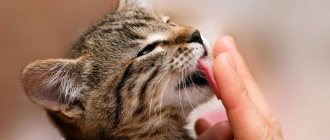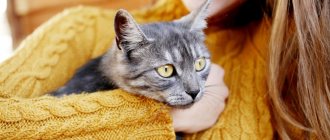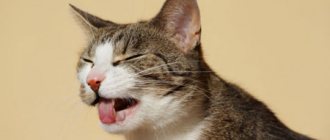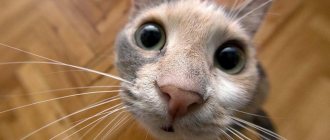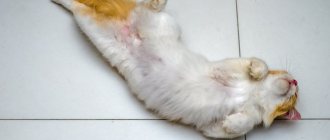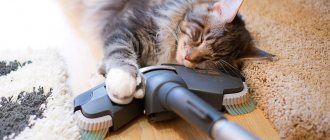Maybe the cat is marking its owner? Or maybe he expresses his love?
Cats love to rub against objects. And it doesn’t matter what it is: a table leg or the owner’s leg. This ritual is performed by cats, regardless of whether they are indoor or outdoor.
The article describes how cats detect odors, why they like to rub against their legs, what this behavior signals, and whether there is danger. You will also learn why it is not recommended to drive away a cat and how to stop an animal from rubbing itself.
How does a cat detect odors?
To obtain information, a person turns on the computer and goes online. Cats learn about the world around them through smell.
From the ears to the tip of the tail, the body of fluffy beauties and handsome men is covered with glands that secrete pheromones - odorous substances.
Through them, animals receive information about their own kind. Nature has given domestic cats two olfactory organs - the normal sense of smell, which functions with breathing, and the vomeronasal organ (VNO), located on the roof of the mouth.
The cat perfectly distinguishes not only ordinary odors, but also the pheromones of other cats.
When the animal opens its mouth slightly, lifting its upper lip, the VNO is activated. Thanks to 31 receptors, furry pets perfectly distinguish between the usual odors and pheromones of other cats.
Cat community, smells and marks
Pets are often forced to share territory in a completely different way than they would in the wild. And yet they were able to adapt to human requirements. But a person needs to learn to distinguish between two types of behavior: social and territorial. Where the cat begins to mark territory, the light, attractive scents of pheromones turn into foul-smelling marks.
Often marks appear when the cat does not perceive its home as a safe territory. If the owner is too detached, pays little attention to the pet, causes physical harm to it, or simply scares it. Timid cats stop petting and start marking if a new animal or family member appears in the house.
Carefully observe your pet's behavior. Where the gentle rubbing on the corner began to be accompanied by a high-raised shaking tail, it’s worth taking a closer look and sniffing to see if this is a mark. The sooner the social is separated from the territorial, the easier it will be to remove the smell of cat urine.
When it comes to labels, behavior needs to be viewed in a completely different way. Then we are no longer talking about such components of sociality as affection and requests from the cat. It is necessary to correct territorial behavior and ask a specialist how to wean a cat from marking.
What does this behavior mean?
The owner, upon returning home, is usually not surprised when he sees his beloved cat, which meets him and immediately begins to walk near his feet, gently but firmly touching them, first with his muzzle and then with his tail. The owner is unlikely to have seriously thought about the question “why is my cat doing this?”
Let's figure out why cats often rub their legs.
Domestic cats consider everything where their scent is left as their property.
And this is not just a lounger, toys, sofa or table leg. The beloved owner also belongs to their “property”. To let other brothers know that the object is occupied, the pet leaves its scent on the owner.
Despite the fact that cats are independent creatures, they become attached to a person and sense his mood well. When a pet begins to rub against its legs, it may sense that its owner is tired or irritated. Touching your legs, purring and shifting from paw to paw are signs of cat care.
Collection of information
The cat considers itself the mistress of the house in which it lives.
She must know everything about her territory. So she marks all the items. And after a while he walks around the property to check. If her scent is gone, she marks things again. The presence of its own scent calms the animal and it feels safe.
The cat marks the owner as part of the territory
A person can carry the smell of a foreign cat on their clothes. The owner's cat will immediately sense this and decipher the stranger's message for itself.
Communication style
Cats, spreading their pheromones, show their attitude towards humans. When an alley cat rubs against his legs, he shows who is in charge. Or perhaps the furry stranger is waiting for affection from a passerby.
The furry hostess, greeting guests and wrapping her tail around their legs, informs the owners that they came with good intentions and she is not against the visit. Cats never approach people they don't trust.
Need for attention
A cat shows love for its owner when it rubs against its legs and purrs at the same time.
In response to her confession, she expects strokes.
If pets spend the whole day at home alone, then when they meet their owner, they may not allow him to take a step, shifting on his slippers and butting him.
The cat is hungry
The reason for “close contact” with the owner’s legs can be significant for the pet – hunger. The furry friend attracts attention to his bowl by purring loudly and fiddling with his owner's clothes. It is foolish to skip a meal if the owner has come to eat a hearty meal. Why shouldn't the cat demand his portion of food? Even if it's not on schedule.
Sexual instinct
If the owners notice that the cat has begun to refuse food, meow mournfully and constantly, and rub against cabinets, the legs of tables or chairs, this can mean one thing: she has gone into heat. Estrus lasts up to 20 days.
The owner has no choice but to be patient and help his pet survive this period.
Heat is physiology
Why cats rub against their legs: 5 reasons
The cat owner believes that the animal can be taught something and required to perform certain actions. And the pet believes that it is able to train the owner so that he carries out exactly his orders. However, only the owner can formulate his judgment about the pet’s behavior.
According to the owner, the cat rubs against its legs for the following reasons:
- Caress the owner and receive more tenderness in return.
- Mark a person's feet or clothing as part of their territory to let other cats know: This is my property. The person does not smell the secretion of the cat's sebaceous glands, so he does not mind.
- Remind the owner that it is time to replenish the food bowl. Or remind the housewife who is cutting up meat or fish that it would be nice to share with her pet.
- Assure the leader of the pride of your loyalty.
- Kitty went on a spree, but so far it has not been possible to attract a person of the opposite sex. Maybe the owner will find a way to ease the suffering at least a little.
The highest concentration of sebaceous glands is located on the muzzle and at the root of the tail. It is with these parts of the body that the cat prefers to come into contact with objects that need to be marked as its own. When a cat is stroked on the face, it purrs with satisfaction. Perhaps because in this way the kitty will be able to mark the palms of the mistress.
Be sure to read:
Why a domestic cat attacks and bites its owner, hisses, what to do
Unfortunately, the aggressive external environment: rain, sun, smells of gasoline, smog, inactivate the marks left by the cat on the owner’s clothes. Therefore, when a person comes home from work, the cat seeks to restore its sovereignty and rubs its muzzle against its legs. At the same time, they manage to bring the owner into a complacent state and beg for something tasty.
Is there any danger?
Domestic cats who adore their owner pose no danger when they mark their owner's feet or belongings. Owners should be concerned if the animal produces a lot of saliva upon contact and behaves lethargically. Your furry friend may be stressed. It is worth taking him to the veterinarian, who will prescribe the appropriate medications.
Stray cats can carry microorganisms on their fur that, when transmitted to humans, cause serious diseases such as rabies, toxoplasmosis and ringworm.
You should not once again allow a stray cat to rub against your legs, unless the person has a noble goal of taking him with him.
Main reasons
Of course, most owners want to find out what else is associated with such features of cat behavior and whether the pet is trying to tell them something. After all, pets not only rub, they often demonstrate various gestures that can be interpreted in a human way.
© shutterstock
For example, you should pay attention if the cat:
- actively wags its tail;
- flattens ears;
- arches, holding the fur on end.
All this indicates a state of tension, fear, interest or combat readiness. But when a cat rubs against its owner, the circumstances under which such behavior occurs should be assessed . For example, if this happens when the owner returns home or enters the room, the ritual may indicate the joy that the pet experiences from the meeting. Moreover, the intensity and duration of friction may directly depend on the duration of separation.
It is also worth paying attention to how exactly the cat does this. If it rubs against the ankles and then gradually rises, the owner has probably been away from home for too long. The cat felt that the smell was lost. In this case, you just need to pet the animal. It will happily restore the smell on your hands too.
However, careful observations may show that the cat is not only rubbing against its owner. From time to time, this phenomenon affects various objects in the house. Among the things that cats most often rub against are: table legs, corners of sofas, favorite toys and much more. The animal tries to leave its scent on those things that it recognizes as personal. This gives the pet a feeling of security. After all, confidence in the integrity of the territory is a very important aspect of a cat’s life .
It is also interesting how the four-legged inhabitants of the streets run up to someone unfamiliar, starting to rub against him. However, not everyone receives such an honor. Essentially, this is how outdoor cats try to impart their scent to an object. This means that they show leniency towards a person, demonstrating that he is part of their property.
© shutterstock
Why is it not recommended to drive away a cat that rubs against its legs?
The habit of rubbing against legs is a kind of ritual in the life of a cat. Animals that are prohibited from doing this experience stress.
The cat is offended if the owner does not allow her to show love
After all, contact with the owner is necessary to feel safe. Don’t forget about the importance of territory for cats.
If a cat does not sense pheromones on its owner, it will choose another way to mark its possessions: by marking shoes. And this is much worse.
Signs
There are many popular signs and superstitions about cats and their behavior towards humans. Here are a few that involve skin-to-skin contact:
- If a cat rubs against a person, and he shows reciprocity, in this way the animal transmits positive energy, and, on the contrary, takes away negative energy;
- If a person pushes away an animal trying to rub against his legs, he drives away luck, strength, luck;
- When a pregnant cat rubs against your legs, it promises a person quick luck, financial gains, and a big win;
- If a strange cat comes into the house and tries to rub itself against the residents, walls, floor, this indicates that evil spirits live here;
- When a cat tries to rub against a person’s face and warily sniffs the air exhaled by him, this indicates the onset of the disease;
- If a dirty, thin, mangy cat wants to rub against a person, it means he or someone close to him will soon get sick.
How to stop your pet from rubbing against your legs?
If owners of furry friends still want to wean their pets from such a harmless habit, they should follow the recommendations:
- When the cat approaches your feet, back away. Pet the animal. Do not Cry.
- If all family members are against cat pheromones on their clothes, stick to the same line of behavior. The cat will understand that no one likes her ritual and will most likely stop rubbing her legs.
Animals love selflessly
Man domesticated the cat thousands of years ago. He let her into his family. In a normal family, each member is respected and his or her characteristics are taken into account. Can such a harmless ritual for humans, but important for a pet, really cause unpleasant feelings? We should not offend those who love us selflessly.
The cat rubs against its legs: should we wean it or encourage it?
If the pet is healthy and has a nice coat, then confusion underfoot should be treated favorably, except for the following cases:
- Begging . When your pet has received his allotted portion of food and asks for more, you should not follow his lead. It is necessary to distribute food distribution so that the cat eats less during the day and more in the evening. To ensure a good, healthy sleep at night. If the cat receives ready-made food, but begs for pieces of meat or fish when cutting it, it is better not to give it. It has been observed that when fed premium or higher prepared foods, cats get sick less and live longer.
- The sterilized cat began to rub herself. An unspayed female may have bred nearby. In order not to provoke sexual behavior, you need to leave.
- The pet is trying to pity the owner and allow him into the child’s bedroom or room, where he is not allowed to enter. What to do? Ignore. The cat will understand that his attempts are not being followed and will stop bothering him.
Be sure to read:
How to scare cats away so that they don’t shit, mark and damage furniture, what smell they can’t stand
A cat that gets under your feet should not be scolded or rudely pushed away, otherwise the pet will experience stress, under the influence of which its behavior will deteriorate.
If friction against the legs of an uncastrated animal is associated with sexual behavior, you can give drugs with phytoestrogens: Kot Bayun, Stop Stress, Vetspokoin. Hormonal contraceptives should be used only with the permission of a veterinarian.
A cat's purr can tell you a lot about its mood and desires.
Scientists have not yet figured out how cats purr, or how they feel. According to one theory, cats purr due to electrical impulses that lead to muscle contraction near the vocal cords. A cat purrs through its mouth and nose at the same time, and the vibration from this sound is transmitted throughout the body.
Most often, cats purr when they need something from a person (food, affection). However, animals often purr because they are lonely and in pain. They try to calm themselves with their rumbling.
If the purring is loud, then the cat is happy and grateful to the person for his attention. If the rumbling is quiet and soft, then most likely the animal is falling asleep. If a cat purrs gently but loudly, then this indicates that she needs something (most often it is with such sounds that the animal greets its owner at home).
A little about smells
In the animal world, obtaining important information, as well as communication between individuals, occurs through smell. Cats' well-developed sense of smell allows them to determine not only the location of prey. Smell helps animals survive in the harsh conditions of the wild and be the first to smell the enemy. With the help of smell, a cat unmistakably finds not only its home, but also small kittens.
Domestic cats have not lost their natural ability to navigate using smells and widely use their sensitive sense of smell in the comfortable conditions of a city apartment. With the help of smell, she determines the territorial boundaries of her possessions. This feature is one of the main reasons why cats rub against people.
There are several zones on the animal’s body that secrete secretions to identify the individual: on the forehead and muzzle, on the paws, and glands located near the anus. Males most often mark territory with urine and the secretion of the paranal glands mixed with it. With the help of scent glands located on the crumbs of its paws, the animal also determines the boundaries of its possessions: it sharpens its claws on a tree or a scratching post. At the same time, the specific smell of a particular individual remains on the objects.
On the face of a domestic cat there are areas that produce odors. There are especially many of them in the forehead area. The odorous secretion is produced by glands located between the ears and in the corners of the lips. This is why owners often observe furry pets rubbing their foreheads and muzzles against objects. Both male and female cats perform this ritual. At the same time, the pets look peaceful, often purr and express pleasure from the process with all their appearance.
In the wild, representatives of the cat family often live in families and clans. Smell helps individuals navigate not only in relation to territorial boundaries, but also in belonging to a particular group. This behavior can also be observed in domestic cats if there are more than 2 pets in the house. They rub against the same object, for example, furniture or a corner of the house, thereby showing that they belong to the same clan.
Possible negative consequences
You should not scream or hit him if he rubs against furniture and interior items, clothes or legs. At this moment the pet experiences a feeling of calm and this is important for him in the place where he lives.
Favorite pet
But sometimes animals are so overwhelmed with feelings and pleasant sensations that they drool. In this case, wherever the pet has been there will be wet marks or dried stains. This always especially affects the owner’s personal belongings, which are the most pleasant for the furry tenant.
Such excessive love and activity can negatively affect the general condition of the cat. Therefore, you should not calmly ignore these cat urges. In this case, you should follow certain rules:
- The main thing is not to treat with your own methods and not to overload with medications. You need to consult a veterinary clinic;
- watch the cat. It is important to understand how he feels when he rubs with saliva;
- Buy a special product at the pet store for spraying in the apartment. They typically contain calming ingredients and scents from other animals;
- If your cat is very weak, in a bad mood, has problems with shortness of breath, or has an extremely rapid heartbeat, you should urgently consult a doctor.
You shouldn’t panic every time your cat wipes himself; as a rule, this is a common thing for him and a completely normal reaction. There is no reason to wean him from this activity. These are natural instincts. It’s better to just be happy and cheer yourself up by playing along with him.
Rubbing on your face
Why do cats rub their faces against their owner’s legs, his face, corners, and everything in a row? What does it mean if the cat also meows?
Marks
There are scent glands on the cat's cheeks, forehead, near the ears, chin and at the base of the tail, so when she rubs or butts a person, she is simply marking him. Kittens usually learn this behavior from their mothers.
Cats have a highly developed sense of smell, which they rely on to receive a significant amount of information about the world around them. In order to distinguish familiar people/animals/objects from unfamiliar ones, she needs to put the “I was here” or “I know him” mark on them.
She wants to live among familiar smells in order to feel confident and safe.
At home, cats most often rub against corners, because instinct tells them that it is at the corner, that is, at the intersection of at least two passages, that there is a greater chance of meeting another animal and showing it that someone was here before it.
It is interesting that if a person comes home to his cat from guests, where their cat rubbed against him, his own cat will try to “re-mark” these marks and therefore will rub with redoubled force. Moreover, cats are more prone to this than cats.
Over time, the marks evaporate, so cats have to regularly rub their faces on people's legs and on all suitable objects in the house.
Greets and studies
This point is related to the first. When a timid cat meets a new person or another cat, she may also rub against him, not only to mark him, but also to greet him and gather information about his scents herself. Moreover, when a cat rubs against a guest’s legs, this does not mean that now she allows him to stroke herself.
The cat wants to be petted
Because people don't realize that their newly adopted kitten is simply marking them, they start petting it in return. This is how he develops a conditioned reflex: if you want someone to scratch your face and behind your ear, rub it against the person.
Begging
Since the feeling of pleasure from food is similar to the feeling of pleasure from scratching behind the ear, the cat begins to ask for food in the same way as it asks for affection, that is, it rubs against the owner. If she is accustomed to receiving food at the first “meow”, then all this will also have a sound accompaniment.
If you do not want to teach your cat to beg in this way, from the very first days do not pet her when she rubs, because this is not what she means.
The cat went on a spree
If a cat begins to unusually actively rub its muzzle on everything, rub its back on the floor or carpet, meow, and when touched by a person, lifts its back, then this is an undoubted sign that it has gone on a spree.
Articles on the same topic:
Why does a cat get underfoot? Why do cats sleep on people? Can cats have chocolate? What happens if you cut a cat’s whiskers?
Cat and laser pointer
LiveInternetLiveInternet
The mood now is good. Why does a cat love to rub against people and surrounding objects so much? In this way, the cat marks objects located in its territory. This allows her to recognize them later and feel confident in familiar surroundings.
To apply marks, the cat uses special temporal glands located on both sides of the forehead between the ears and eyes. Similar organs are also present around the lips, more precisely, near their corners (perioral glands).
They secrete secretions that a cat leaves on doors, stair railings and furniture legs when it rubs its head against them, such glands are also present on the tail: they also secrete a similar secretion that a cat applies by raising its tail with a pipe and moving it over a selected object . Glands can also be found around the anus and probably on the pads of the feet.
Showing its favor towards a person, a cat leaves its marks on it, rubbing its muzzle and tail against it, often purring loudly. This behavior is one of the signs of affection that kittens show to their mother. At the same time, the person the cat rubs against is identified as part of its territory.
Are cats cunning? Anyone who has lived under the same roof with a cat for a long time knows its habits. And a person who does not have a cat, coming to a house where there is one, often does not understand its behavior: what it intends to do, what it prefers, and what it does not like. For example, a cat is unlikely to allow a stranger to stroke itself, and if he If he turns out to be too persistent, he may even use his claws.
But she will never do this without warning: before releasing her claws, she will hiss, pressing her ears to her head. An experienced cat lover will never be the first to approach an unfamiliar cat; he will let her walk around, look at him, and only then carefully extend his hand so that the animal can smell it. If the cat likes the person, it will come closer and arch its back, allowing itself to be stroked.
A cat greets a familiar person in a special way. Raising her tail high, she hurries towards him, as soon as she sees him on the threshold, purrs loudly, rubs her muzzle and sides against her legs, and sometimes even stands on her hind legs to be stroked. And then he sits down somewhere in a corner and begins to lick himself. This greeting ritual is necessary for the exchange of smells.
On the temples and in the corners of the cat’s mouth there are glands that produce an odorous substance, which it distributes throughout the fur. When a cat rubs against its leg, it leaves its scent on it and at the same time perceives the scent of its owner. And when he then licks himself, he feels this smell more clearly. Our coarse noses can hardly catch anything like that.
Familiar cats rub their fur and lick each other, also exchanging smells. For a cat that lives in a world of smells, the sense of smell plays a very important role. It often happens that a cat slightly bites the hand that is caressing it. This is a sign of friendship, and many people take it incorrectly. A person may even get angry with a cat because it is so unexpected and sometimes painful.
But the cat does not at all want to offend - when she bites, she leaves her saliva on our “fur” (the cat is sure that we also have it) and thus once again marks “her.” It is believed that she also accepts “her” person for the cat and expresses this through behavior similar to how a kitten treats its mother.
Here's a typical example: a cat sits comfortably on its owner's lap and moves its left and right paws, as if lightly massaging or kneading something. Many people don't like it because it produces claws that pierce the dress or pant leg and scratch the skin. The answer is simple: the kitten used to make similar movements when it fed milk from its mother's nipple.
Ethologists, specialists in animal behavior, called this action the “milk step.” Adult cats have very pleasant memories of their mother's milk. Therefore, the cat will become worried if you remove it from your lap at this moment, because the stroking hand caused the same sensation as the tongue of the mother cat, who once licked the kitten. Why do cats purr? A cat has many ways to show what it wants.
A true connoisseur will always understand what his pet needs only by seeing how she sits, how she walks, in what position her ears, whiskers or tail are. If a cat is unhappy, she usually swings her tail in different directions; if she fluffs up her fur and arches her back, it means wants to inspire respect for his person.
And if you were gently touched by a cat’s paw, then it’s time to remember about your friend and think if he needs anything. When a cat rubs against its legs, it means that it greets you or reminds you that it needs to be fed. Even more diverse is the variety of sounds for which in our language there is only one word - “meow”.
From a gentle purr to a piercing cry, a cat can express many different emotions using its voice. And she loves to talk. She meows for any reason: greeting or demanding something, calming you down or being tender, complaining or upset, happy or sad, begging or angry and even threatening.
If you gradually begin to listen carefully to meowing, then over time you can learn to understand the character, mood and desires of your friend. Probably the most pleasant thing is to listen to a cat purr, to feel that she is happy. When the kitten is only a week old, he is already purring, telling his mother cat that everything is fine.
Adult animals usually purr when they are simply in a good mood. Even if a cat goes hunting alone, she does not forget that she is a member of the feline community. And in rural areas, dozens of semi-wild animals often live together. Cats in such “families” lick each other’s fur, sleep together, curled up in a cozy ball, and take turns feeding the kittens. Professor Paul Leyhausen was the first to describe one of the most mysterious cat habits, the so-called “informal meeting among friends.” All animals living in the same area, which meet on the same paths during the day, often argue and even fight over hunting territory, and by the beginning of twilight they gather in some corner. There they sit quietly and peacefully at a distance of several meters from each other and only at midnight they disperse again. Nobody knows why cats do this. No wonder the cat is called the most mysterious animal.
Source
Why does a cat rub its face against corners? The cat is rubbing
Most people understand that cats rub against their legs as a result of positive emotions. Some people understand this act as affection and affection, while others think that the cat is asking to be held or asking for pity. You will be surprised, but there are well-founded, physiological reasons for such cute behavior!
Let’s immediately make a reservation that the cat rubs against the owner’s legs in order to mark him as property and inviolable property! Cats (and dogs too) have three “sources” of personal odor - secretions secreted by glands on the face, between the toes and on the surface of the anus. Another “ink” to mark the territory is urine, which has no “significant” odor without the secretion secreted by those same paranal glands.
Note! When a cat marks territory, it jerks its tail held high to stimulate the paranal glands.
Sometimes, odorous substances are called pheromones; this interpretation is a little incorrect, but sometimes it is appropriate. Some, especially territorial cats, not only rub against their owner, but also lick him. Particularly passionately, the pet eliminates the smell of sweat under the arms and on the legs. We can explain the not entirely hygienic process by the same desire to mark a person with one’s smell.
Note! "Wet deeds" found in shoes also indicate an attempt to leave a mark. It is incorrect to write on a person, but leaving your scent on shoes is quite appropriate. Males can mark hats and outerwear.

